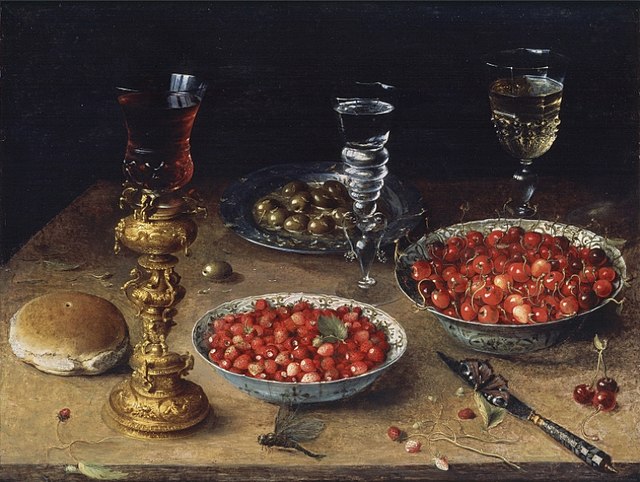
The Quest for the Smallest Painting in the Louvre
Unlike the large scale masterpieces that dominate the museum’s halls, the smallest painting in the Louvre is easy to overlook. Tucked away in the museum’s expansive galleries, this diminutive artwork doesn’t draw crowds like its larger or more famous counterparts. Yet, it carries a unique charm and significance, proving that size does not determine the value or impact of art.
The honor of being the Louvre’s smallest painting belongs to Still Life with Cherries and Strawberries in China Bowls by the Dutch painter Adriaen Coorte. This small gem measures just 14 cm by 12.5 cm (5.5 inches by 4.9 inches) barely larger than a postcard. Its modest size stands in stark contrast to the colossal canvases that dominate the museum, offering a reminder of the quiet intimacy and detailed precision that smaller works can achieve.
A Closer Look at Still Life with Cherries and Strawberries in China Bowls
Adriaen Coorte, a Dutch Golden Age painter, is known for his small-scale, minimalist still-life paintings. Active in the late 17th and early 18th centuries, Coorte specialized in creating quiet, meticulously detailed compositions that focused on everyday objects such as fruits, nuts, shells, and ceramics. His works are celebrated for their simplicity, harmony, and attention to texture and light.
The Painting’s Composition
Still Life with Cherries and Strawberries in China Bowls is a perfect example of Coorte’s artistic philosophy. The painting depicts two porcelain bowls: one filled with plump, red cherries and the other brimming with ripe strawberries. The bowls rest on a simple, dark surface, with a black background that accentuates the vibrant colors of the fruit. The light in the painting is soft yet focused, casting gentle shadows that add depth and dimension to the objects.
Despite its size, the painting showcases Coorte’s mastery of detail. The glossy sheen of the cherries, the tiny seeds on the strawberries, and the delicate patterns on the porcelain bowls are rendered with incredible precision. The composition exudes a sense of tranquility and timelessness, inviting viewers to pause and appreciate the beauty of ordinary objects.
The Significance of the Painting
In an era dominated by grand historical and mythological themes, Coorte’s modest still lifes were a departure from the norm. His works reflect a shift in artistic focus toward the everyday and the personal, celebrating the simple pleasures of life. This perspective resonates with modern audiences, who often find solace in the understated beauty of his art.
The Journey to the Louvre
The story of how Still Life with Cherries and Strawberries in China Bowls found its way to the Louvre is as intriguing as the painting itself. Like many works by Adriaen Coorte, the painting was relatively obscure for much of its history. Coorte’s art fell out of favor after his death and remained largely forgotten until the 20th century, when art historians rediscovered his work and began to recognize its significance.
The painting entered the Louvre’s collection as part of a larger acquisition of Dutch and Flemish art. Its inclusion reflects the museum’s commitment to representing a diverse range of artistic styles and periods. Today, the painting occupies a small but significant place in the Louvre’s collection, offering visitors a glimpse into the quiet brilliance of Adriaen Coorte.
The Charm of Small Artworks
The appeal of small paintings lies in their intimacy and accessibility. Unlike large-scale works that can overwhelm with their grandeur, small paintings draw viewers in, inviting them to examine the details up close. This sense of closeness creates a personal connection between the artwork and the viewer, making the experience of viewing small paintings uniquely engaging.
A Counterpoint to Monumentality
In the context of the Louvre museum, where monumental works dominate the landscape, the presence of a small painting like Still Life with Cherries and Strawberries in China Bowls serves as a counterpoint to the grandeur of larger masterpieces. It reminds visitors that art is not defined by scale but by the emotions it evokes and the stories it tells.
Exploring the Role of Scale in Art
The concept of scale plays a crucial role in art, influencing how viewers perceive and interact with a work. Large scale paintings often aim to impress, conveying power, drama, or grandeur. In contrast, small-scale works emphasize intimacy, detail, and personal connection.
Historical Context
Throughout history, artists have used scale to serve different purposes. During the Renaissance, large altarpieces and murals were designed to inspire awe and convey religious narratives to wide audiences. In contrast, the Dutch Golden Age saw the rise of smaller, more personal works like Coorte’s still lifes, reflecting a shift in focus toward individual experience and domestic life.
Modern Interpretations
In contemporary art, the interplay between scale and meaning continues to be a rich area of exploration. Artists experiment with size to challenge traditional notions of art and to create new ways of engaging with audiences. The smallest painting in the Louvre, though rooted in the traditions of the Dutch Golden Age, resonates with these modern ideas, demonstrating the enduring relevance of small-scale art.
Visiting the Louvre: A Journey of Discovery
For visitors to the Louvre, the experience of discovering Still Life with Cherries and Strawberries in China Bowls can be a highlight of their journey. Amid the vast collection of iconic works, the painting offers a moment of quiet reflection and appreciation for the small details that often go unnoticed.
Tips for Finding the Painting
Given its size and the sheer scale of the Louvre, locating the smallest painting in the museum can be a challenge. Visitors are encouraged to consult the museum’s map or seek assistance from staff to find the gallery where the painting is displayed. Taking the time to seek out this hidden gem can be a rewarding experience, offering a fresh perspective on the museum’s collection.
The Beauty of Small Wonders
The smallest painting in the Louvre, Still Life with Cherries and Strawberries in China Bowls, is an evidence to the power of art to captivate and inspire, regardless of size. Through its exquisite detail and quiet beauty, the painting invites viewers to slow down, look closely, and find joy in the simple pleasures of life. It serves as a reminder that art is not only about grandeur and spectacle but also about the moments of quiet intimacy that connect us to the world around us.
In a museum filled with monumental masterpieces, this tiny painting holds its own, proving that even the smallest works can leave a lasting impression. For those who take the time to discover it, Still Life with Cherries and Strawberries in China Bowls offers a unique and unforgettable experience, highlighting the timeless appeal of art in all its forms.




